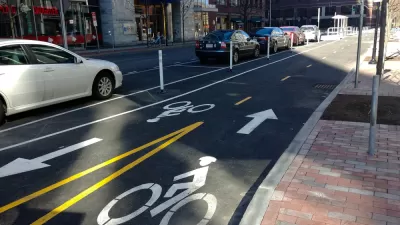The Governors Highway Safety Association released a report titled Bicyclist Safety showing a surge in bike fatalities since 2010. The report provoked widespread media coverage and, also, strongly critical reactions.
The Governors Highway Safety Association's Bicyclist Safety report claims bike fatalities spiked by 16 percent between 2010 and 2012. From the press release announcing the report: "The number of bicyclists killed on U.S. roadways is trending upward, particularly for certain subsets of the population....yearly bicyclist deaths increased 16 percent between 2010 and 2012, while overall motor vehicle fatalities increased just one percent during the same time period."
Michael Andersen and Tanya Snyder counter the claims of the report by noting that the bike fatalities nationwide are lower than historic highs set in 1975—even though bike ridership is currently soaring. So, "what’s actually happening is that for an infinitesimal fraction of the cost of the nation’s transportation system, Americans are enjoying billions more bike trips every year than they were a generation ago. And because the sheer number of bikes on the street is teaching drivers to keep an eye out for bikes, every single bike trip is far, far safer than it was." Andersen and Snyder make a number of other convincing arguments refuting the methodology and rhetoric of the report.
Anderson and Snyder note that the GHSA's report was picked up by the Des Moines Register, NJ.com, and the Washington Post. Planetizen notes that it was also picked up by Governing and the San Jose Mercury News.
Andersen and Snyder conclude with this appeal: "Reporters and editors treat the GHSA with respect because it describes itself as 'The States’ Voice on Highway Safety.' State officials who are interested in helping their residents safely enjoy the benefits of biking might want to consider whether, on this issue, the GHSA is actually speaking for them."
FULL STORY: Don’t Believe the Headlines: Bike Boom Has Been Fantastic for Bike Safety

Study: Maui’s Plan to Convert Vacation Rentals to Long-Term Housing Could Cause Nearly $1 Billion Economic Loss
The plan would reduce visitor accommodation by 25,% resulting in 1,900 jobs lost.

North Texas Transit Leaders Tout Benefits of TOD for Growing Region
At a summit focused on transit-oriented development, policymakers discussed how North Texas’ expanded light rail system can serve as a tool for economic growth.

Why Should We Subsidize Public Transportation?
Many public transit agencies face financial stress due to rising costs, declining fare revenue, and declining subsidies. Transit advocates must provide a strong business case for increasing public transit funding.

How to Make US Trains Faster
Changes to boarding platforms and a switch to electric trains could improve U.S. passenger rail service without the added cost of high-speed rail.

Columbia’s Revitalized ‘Loop’ Is a Hub for Local Entrepreneurs
A focus on small businesses is helping a commercial corridor in Columbia, Missouri thrive.

Invasive Insect Threatens Minnesota’s Ash Forests
The Emerald Ash Borer is a rapidly spreading invasive pest threatening Minnesota’s ash trees, and homeowners are encouraged to plant diverse replacement species, avoid moving ash firewood, and monitor for signs of infestation.
Urban Design for Planners 1: Software Tools
This six-course series explores essential urban design concepts using open source software and equips planners with the tools they need to participate fully in the urban design process.
Planning for Universal Design
Learn the tools for implementing Universal Design in planning regulations.
Ascent Environmental
Borough of Carlisle
Institute for Housing and Urban Development Studies (IHS)
City of Grandview
Harvard GSD Executive Education
Toledo-Lucas County Plan Commissions
Salt Lake City
NYU Wagner Graduate School of Public Service




























